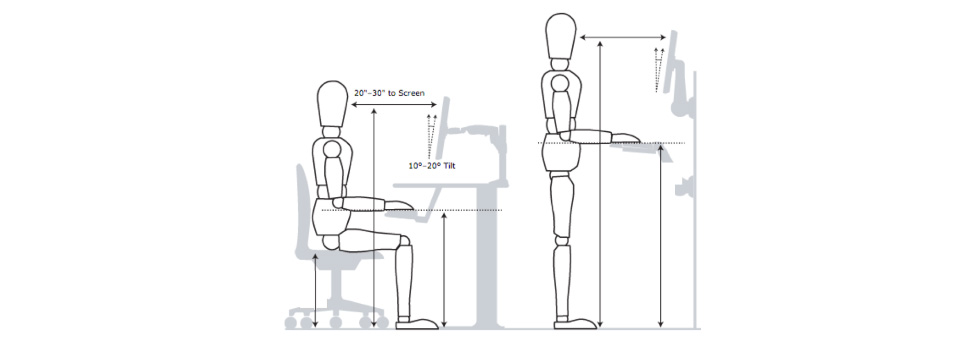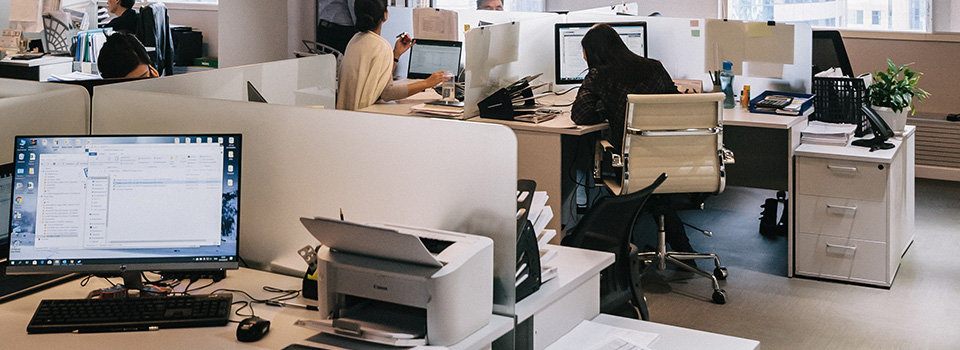For anyone who works at a desk, the term “office ergonomics” is probably very familiar. And, for most of us, the term brings to mind images of over-expensive office furniture. And its not that far off the mark, considering a quick google search for the word “ergonomic” comes back with lots of results for office chairs of questionable progeny starting at around $100.00 and going on up to figures of over $1,000.00. But aside from its marketing implications, what is ergonomics, really?
Ergonomics is a scientific field. It is the study of the kind of work you do, the environment you work in, and the tools you use to do your job. Its about setting up your work environment to suit the way your body works, in order to increase comfort, boost productivity and prevent injury. The logic isn’t that hard to follow, really. If your office environment is an easy place for you to do your job because it’s comfortable, then you’ll be able to accomplish more work with less distractions. And with less aches and pains, you’ll have less absences, which will also increase your output.
But does that mean you have to buy that expensive chair? Let’s examine that together!
As it turns out, there are a lot of things you can do to improve your workplace ergonomics. Many of them are simple adjustments that cost nothing. Others may require special equipment. Here are 6 tips to help you improve your office environment. Each of them can make a difference by itself. But, when combined together, they can dramatically change your comfort level in the office. The more of these tips that you follow, the more complete your ergonomic environment will be. Read on, to learn more!
1. Lighting
Believe it or not, the quality and brightness of your light source can greatly impact your mood, morale, levels of concentration and anxiety. If your lighting is too dim or too bright, you’ll struggle to see. As much as possible, use natural lighting, such as from a window. If possible, adjust your desk so window light reaches it at a side-angle rather than from behind you or in front of you. If you work at night, or you’re not able to get natural sunlight, then there are special lamps available that simulate natural sunlight.
2. Plants
Studies show that live plants in the workplace can increase productivity by as much as 15 percent, which might be surprising. Specifically, during work that requires intense concentration, a potted plant can help to prevent fatigue and keep you focused.
Unfortunately, many people out there are cursed with a “brown thumb,” that is, they can’t seem to keep plants alive. This makes it difficult to take advantage of this tip. But it really doesn’t have to be that hard. It all comes down to the type of plant you choose. Well, I’m here to help! Here’s a great blog post I found from Kevin Twitty Interiors about 12 plants that even you can keep alive!
3. Temperature
Overly cold air conditioning can kill your productivity at work. During the summer months, especially, everybody enjoys a blast of cool air to overcome the sweltering conditions outside. But interior temperatures that are too low increase typing errors by as much as 44%. By raising your office thermostat to 77 degrees Fahrenheit (25 degrees Celsius), you can type as much as 150% more. That’s because cold fingers are stiff fingers.
4. Sounds
Let’s face it, we’ve all been frustrated by noise-related distractions from time to time. Anything from your mobile phone to the keyboard rattling in the neighboring cubicle can get on your nerves and reduce your productivity. And then there are external sounds such as traffic, construction, etc., to contend with. Unfortunately, there’s really only one way to really drown out the noise, and it does have a cost. But a good pair of noise-canceling headphones are a great investment if improving productivity is your goal.
Here’s a great article from musiccritic.com about affordable and good-quality noise-canceling headphones to help you tune out the distractions!
5. Color
It may surprise you how much environmental effect you’ll see from a fresh layer of paint in your office. But color really does affect our psychology. Red, for example, can stimulate you to be energetic and aggressive. Blue can help you concentrate and communicate better. Green can help you relax and unwind. So, if you have a home office, you can paint it however you want it. However, if you’re in a communal office and you don’t have any control over the paint on the walls, all hope is not lost. Chances are you do have some control over the décor in your individual cubicle or desk area. So, focus on color themes that will suit your needs. Here’s a blog post from 99designs.com that you can read for more information about the emotional impacts of different colors in decorating.
6. Desk and Seating Positions
How high should your desk really be? Where should you put your monitor? The ergonomically correct answer to both of these questions is “whatever height or distance fits your body’s size and shape.” This non-specificity is the exact reason there’s such a market out there for ergonomic chairs and furniture. No two people are exactly the same, so adjustability is the key. The common feature of most ergonomic furniture is that they are highly adjustable to suit their user. The more points of adjustment that a given chair has, the more complex it is. And that’s what makes it more expensive. But you don’t have to have the most expensive ergonomic chair to be effective for you.
Ideally, your computer’s keyboard should be at a height and position that allows your upper arms to hang vertically, while your forearms remain parallel to the floor. This should be achieved while your back is straight, not slouched. This applies to both sitting desks and standing desks. The top of your screen should be at eye level, and its position should be 20-30 inches (about 50-75 cm) from your eyes. Your chair height should be adjusted so that your upper legs are parallel to the ground, with your lower legs perpendicular and your feet flat on the floor.

Special furniture may be too costly for you or your employer, but you don’t necessarily have to do it the expensive way. In my home office, I installed a cheap, adjustable keyboard tray on my existing desk and raised my monitor by stacking old textbooks under it. And there are inexpensive lumbar supports you can attach to your existing chair to keep your sitting posture straight. A little improvisation can go a long way to keeping you comfortable and productive.
So, office ergonomics is the science of making your workspace workable. You can do a lot to improve your working environment, and it doesn’t have to cost you a fortune. But a little bit of specialized equipment can benefit you if you can afford it.



Trackbacks/Pingbacks